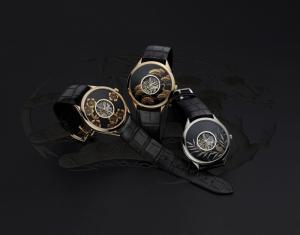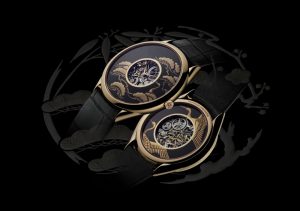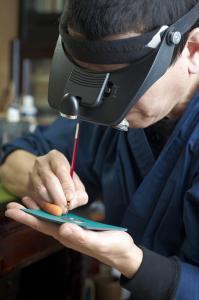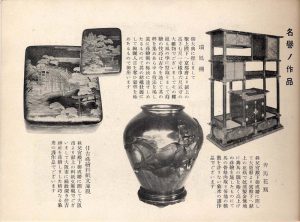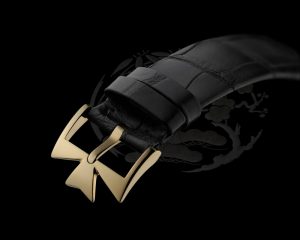A new chapter in Vacheron Constantin Métiers d’Art: La symbolique des laques
An encounter between Vacheron Constantin, which in 2005 marked 250 years of activity in Geneva, and Zôhiko, which will celebrate its 350th birthday in Kyoto in 2011…
Together, more than 600 years of history.
The incredible reaction to the Métiers d’Art – Les Masques collection born of the encounter between Vacheron Constantin and Geneva’s Barbier-Mueller Museum has only strengthened the watch manufacturer’s conviction that today, more than ever, it is important to match the cultural and artistic trades with watchmaking of the highest technical quality.
Such a combining of talents, associating both technical and decorative virtuosity with accuracy, perfectly illustrates Vacheron Constantin’s core values: seeking excellence, supporting creativity, being open to the world, respecting and handing down traditions, and finally, sharing the passion.
Now, the brand is opening up a whole new horizon for combining watchmaking and decorative techniques, by offering for the first time a Métiers d’Art collection in which part of the work is done outside Geneva – and in fact on a far-off continent, since mysterious term maki-e refers to the crown jewel of traditional ancestral Japanese lacquer techniques.
How the “Métiers d’Art – La symbolique des laques” collection came about
The idea of a project combining maki-e and watchmaking had long been filed away in the drawers of Vacheron Constantin’s design department. But the spark that would bring it to life had never been found. The spark was finally to come from Zôhiko, which had the same idea in reverse – combining the talents of the watchmaking arts with those of the lacquer arts.
The reference to “Masks” is no coincidence: it was the technical and artistic boldness and the beauty of this collection that encouraged Zôhiko to introduce itself to Vacheron Constantin in the autumn of 2007, to explore the possibility of cooperating.
While chance and luck play a role in every meeting, a true relationship can be built only on the basis of deep affinities and shared values. These developed immediately between the two companies, both of which have the same fundamental respect for cultural, technical, and artistic traditions. Vacheron Constantin is the repository of an uninterrupted history dating back to 1755, and Zôhiko, founded in 1661, is almost a century older. The two together have garnered 600 years of experience and expertise.
Above all, however, this collection is a human adventure. It is a voyage through and exploration of an unknown “great beyond” in which craftsmanship and innovation come together at their zenith. Of this union between the craftsmen of one of the oldest Japanese lacquer companies, Zôhiko – headquartered in Kyoto since its founding in 1661 – and Vacheron Constantin – the world’s oldest watchmaker, which has been making watches in Geneva without interruption since its beginnings in 1755 – was born a remarkable embodiment of the same core values: the Métiers d’Art – La symbolique des laques collection.
What is maki-e?
Maki-e 蒔絵 – which literally means “sprinkled picture” – is the most sophisticated of all lacquer techniques, designating a decorative operation in which the design is created by delicately sprinkling gold or silver dust over lacquer – usually black – while it is still wet.
The lacquer is made from the sap of the lacquer tree, Rhus verniciflua. This tree, a relative of poison ivy, originated on the high plateaus of central Asia or Tibet. Today, it grows only in southern China, Korea, Vietnam and Japan, but it seems to have had a much wider range in the past. In Japanese, the word for the substance and the name of the tree are the same: urushi 漆.
Lacquer techniques vary from country to country and are based on the quality of the lacquer and the use to which the objects will be put. The three categories most representative of the lacquer arts are carving, inlay, and maki-e. The number of possibilities is almost infinite, and the invention of maki-e and its variations by the Japanese is one of the most remarkable marriages of technical mastery and aesthetic sophistication in all the history of art. This decorative technique developed very early in Japanese history. It matured as an art form between the eighth and twelfth centuries A.D., becoming the predominant method of ornamentation beginning in the seventeenth century and remaining so to this day. It does not seem to have been used in China – or if it was, it disappeared very early on. It was highly prized there, however, as evidenced by the many orders placed from the continent over the centuries. Maki-e’s own rise allowed the techniques it involves to blossom as well. Beginning in the mid-tenth century, this technique far surpassed all its rivals and was heavily preferred over them for the delicacy of its execution, its quality of being distinct yet misty at the same time, and its incredibly poetic presence.
One of the greatest beauties of lacquer is that it can decorate the most precious of objects as easily as those used in everyday life. Lacquerware bowls and crockery have come down through the centuries, as have variously shaped boxes with all sorts of uses: document holders, tea caddies, incense boxes, paintbrush holders, inkwells, card cases, pill boxes, etc. While there has always been lacquered furniture, the preference has almost always been for small objects, for work that is enchanting in its meticulous perfection.
Zôhiko
In 1661, Yasui Shichibei 安井七兵衛 (1632–1692) opened a shop he named Zôgeya 象牙屋 “At the Sign of the Ivory”, where he sold lacquer-ware and Chinese products. His successor was Kusunoki Jihei 楠治兵衛 (1659–1714), who focused on lacquerware. The shop remained in the family for five generations before passing to Nishimura Hikobei 西村彦兵衛 (1719–1773), then head of production, because there were no heirs in the Kusunoki branch. Kusunoki Jirôbei 楠治郎兵衛 (1723–1784) left not only the shop but also the task of caring for his family’s tombs to his senior assistant, thus creating an indissoluble tie of successorship. From that day down to this, Zôhiko has been run by members of the Nishimura family, each of whom has taken the founder’s first name. Zôhiko’s current director is the ninth Nishimura Hikobei.
The third Hikobei (1806-1875) was granted the title “Master of maki-e” by the Emperor for the excellence of his work. One of his most remarkable pieces is a maki-e panel representing the Fugen Bodhisattva on a white elephant. History says that the people of Kyoto were so charmed by the beauty of this image that they named it the “Zôhiko panel,” with “Zô” meaning the elephant and “Hiko” being the first part of Hikobei’s first name. This is the origin of Zôhiko’s company name.
Zôhiko has had a longstanding relationship with the Japanese Imperial Court. The fourth Hikobei was one of the Court’s official suppliers, and the current director made the reigning emperor’s official seat. The workshop’s first exports date to the very end of the nineteenth century, upon Japan’s opening to abroad after the Meiji restoration. The company’s expanded horizons were the work of the eighth Hikobei (1887-1965). He was unanimously considered to be a pioneering figure in the lacquer industry. He also founded a maki-e school that became a standard of reference for many specialized lacquer artists.
Zôhiko’s long history reflects a tradition of excellence that is unparalleled in its respect for both artistic continuity and continually renewed creativity. While continuing to cultivate a tradition that is already over a thousand years old, Zôhiko upon to the world. Sharing with Vacheron Constantin gave rise to an extraordinarily intense collaboration, the fruit of which is called the Métiers d’Art – La symbolique des laques collection.


